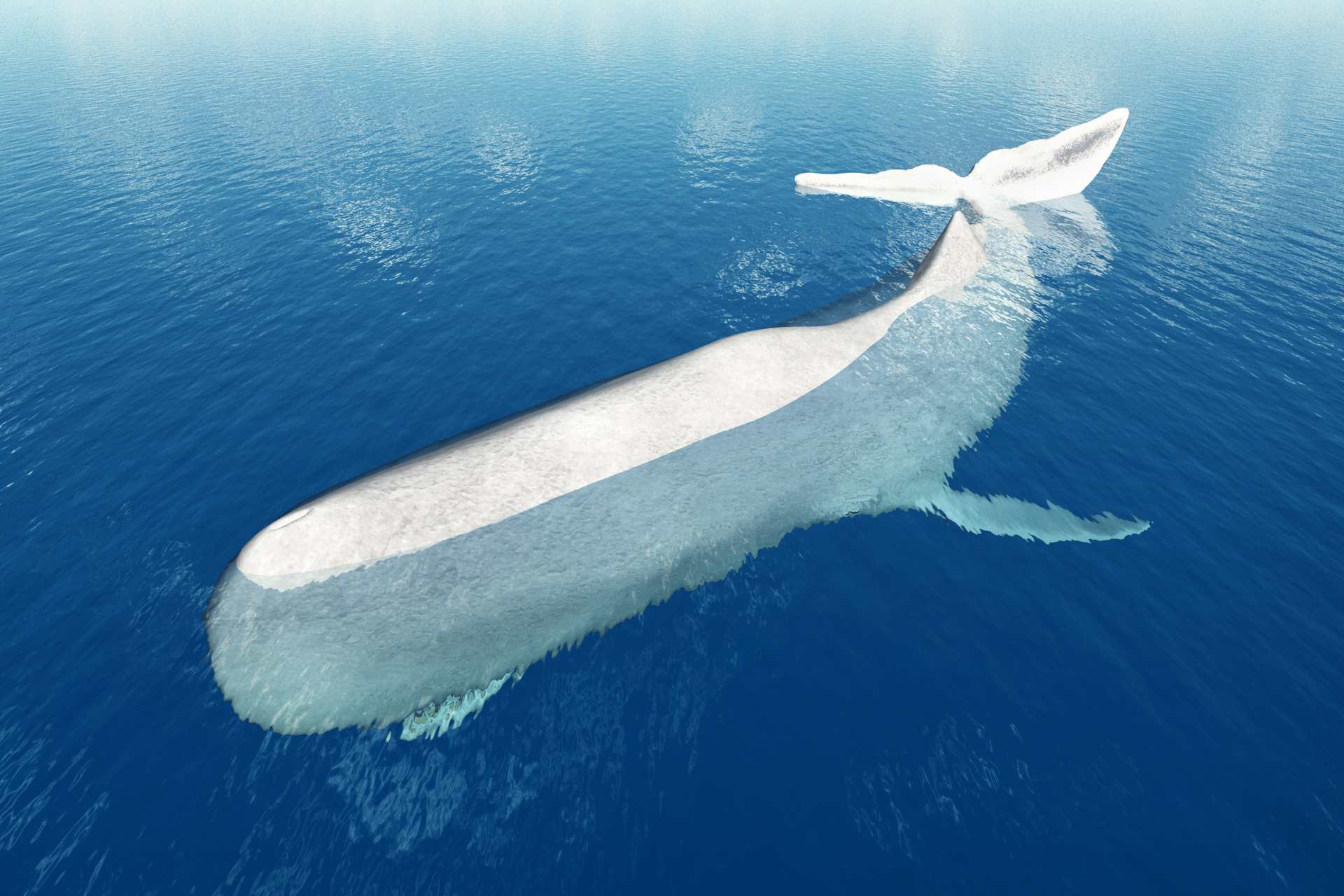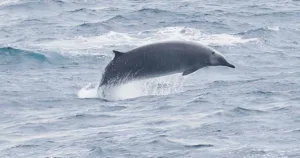Sperm Whales: The Gentle Giants of the Ocean Depths
Meet the sperm whale, the ocean’s biggest mystery! These huge creatures are more than just giants swimming in the deep blue. They’ve got some super cool secrets, and we’re about to dive in to find out what makes them so special. Imagine a creature so big that it can talk with sound waves and hold its breath for crazy long times! Get ready to splash into the world of sperm whales and discover why they’re the superheroes of the sea.
Fascinating Facts about Sperm Whales
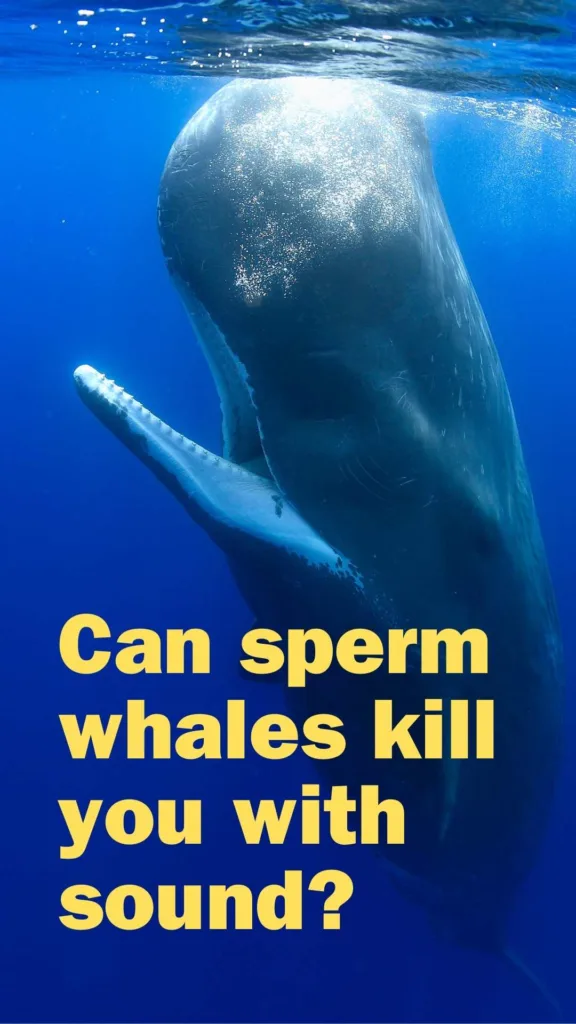

Why are sperm whales called “sperm whales”?
Sperm whales are called “sperm whales” because of the spermaceti organ found in their heads. This organ is filled with a waxy substance called spermaceti, which early whalers mistakenly believed to be sperm.
Are sperm whales dangerous to humans?
Sperm whales are generally not dangerous to humans. There have been very few incidents of sperm whales attacking boats or humans, and such behavior is not typical.
Are sperm whales endangered?
The International Union for Conservation of Nature (IUCN) considers sperm whales vulnerable, primarily due to past whaling. However, they are protected under various conservation laws.
Are sperm whales extinct?
No, sperm whales are not extinct. They are currently listed as vulnerable, but they exist in oceans around the world.
How many sperm whales are left in the world?
It’s estimated that there are approximately 200,000 to 1,500,000 sperm whales left in the world’s oceans, though exact numbers are difficult to determine.
Are sperm whales aggressive?
Sperm whales are not typically aggressive towards humans. They are social creatures that live in groups and show complex behaviors but are not known for aggression.
Will sperm whales attack humans?
No evidence suggests that sperm whales actively seek out or attack humans. Encounters between sperm whales and humans are rare and usually not aggressive.
Are sperm whales carnivores?
Yes, sperm whales are carnivores. They primarily eat squid, including giant and colossal squid, and also consume fish and other deep-sea creatures.
Are sperm whales smarter than humans?
While sperm whales have large brains and exhibit signs of intelligence, including complex social structures and communication, comparing their intelligence directly with humans is inaccurate. They are intelligent in ways that are adapted to their environment.
Are sperm whales mammals?
Yes, sperm whales are mammals. They are warm-blooded, breathe air, give birth to live young, and nurse their calves with milk.
Are sperm whales considered dolphins?
Sperm whales are not considered dolphins. They belong to the order Cetacea, which includes whales, dolphins, and porpoises, but they are classified under the family Physeteridae, separate from dolphins.
Are sperm whales apex predators?
Yes, sperm whales are considered apex predators in their marine environment due to their size and diet, which includes large prey like giant squid.
Can sperm whales kill you with sound?
Sperm whales produce powerful clicks that are used for echolocation and communication. While these sounds are incredibly loud, there’s no evidence they can kill a human with sound.
Can sperm whales eat humans?
There is no documented case of a sperm whale eating a human. Their throats are not large enough to swallow a human whole.
Can sperm whales kill orcas?
While orcas (killer whales) sometimes prey on young or weak sperm whales, adult sperm whales can defend themselves effectively, and there are records of sperm whales injuring or deterring orcas.
Can sperm whales swallow a human?
No, the throat of a sperm whale is too narrow to swallow a human.
Can a sperm whale kill a megalodon?
The megalodon is an extinct species of shark that lived millions of years ago, so a sperm whale could not encounter or kill a megalodon. In a hypothetical scenario, a sperm whale’s ability to injure a megalodon would be limited. While sperm whales have powerful jaws and teeth found in the lower jaw, these are primarily used for grasping large squids, not for fighting. The megalodon’s size, powerful bite, and adaptation to predation would give it a significant advantage. Therefore, while it’s a fascinating thought experiment, it’s unlikely that a sperm whale could kill a megalodon if they were to encounter each other.
How do sperm whales sleep?
Sperm whales sleep vertically in the water, often suspended near the surface. They can sleep like this for short periods, ranging from a few minutes to around an hour.
How do sperm whales hunt?
Sperm whales hunt by diving deep into the ocean, using echolocation to find their prey, primarily squid. They can dive as deep as 2,000 meters and hold their breath for up to 90 minutes.
How do sperm whales reproduce?
Sperm whales reproduce sexually, with females giving birth to a single calf after a gestation period of about 15 to 16 months. Calves are nursed for several years.
How do sperm whales communicate?
Sperm whales communicate using a complex series of clicks, known as codas, which can convey information and are believed to be used for social interactions.
How do sperm whales dive so deep?
Sperm whales are adapted to deep diving with flexible ribcages, high levels of myoglobin in their muscles for oxygen storage, and the ability to reduce their heart rate to conserve oxygen.
Should sperm whales be kept in captivity?
Sperm whales should not be kept in captivity due to their size, complex social structures, deep-diving habits, and need for a wide-ranging ocean environment.
What do sperm whales eat?
Sperm whales primarily eat squid, including giant and colossal squid. They also consume fish and other deep-sea creatures.
When do sperm whales migrate?
Sperm whales do not follow a strict migration pattern but move in response to the availability of prey. Their movements are more accurately described as seasonal or feeding migrations.
Where are sperm whales found?
Sperm whales are found in deep oceans all around the world, from the equator to the edge of the polar ice in both hemispheres.
Which is bigger, a sperm whale or a humpback whale?
The sperm whale is generally larger and heavier than the humpback whale, with males reaching lengths of up to 20.5 meters (67 feet).
Who eats sperm whales?
Large sharks and orcas may attack young or weak sperm whales. However, adult sperm whales have few natural predators due to their size.
Did sperm whales attack ships historically?
There are historical accounts of sperm whales attacking ships, most famously the case of the Essex, which inspired the novel “Moby-Dick.” However, such incidents are extremely rare.
How do sperm whales use echolocation?
Sperm whales use echolocation by emitting a series of clicks. These sounds bounce off objects in the water, and the returning echoes help the whale navigate and locate prey, even in complete darkness.
Understanding Sperm Whales: An Overview
Sperm whales are one of the ocean’s most iconic species. As the largest of the toothed whales, they capture our imagination with their size, deep-sea diving abilities, and complex social behaviors. Here’s a look at what makes these giants of the depths so fascinating.
Physical Characteristics
When you picture a sperm whale, think of a creature of monumental proportions. They have a distinctive block-shaped head for about one-third of their body length, large flippers, and a small dorsal fin located further back on their body. Their skin is usually dark and grayish and can appear wrinkled or smooth.
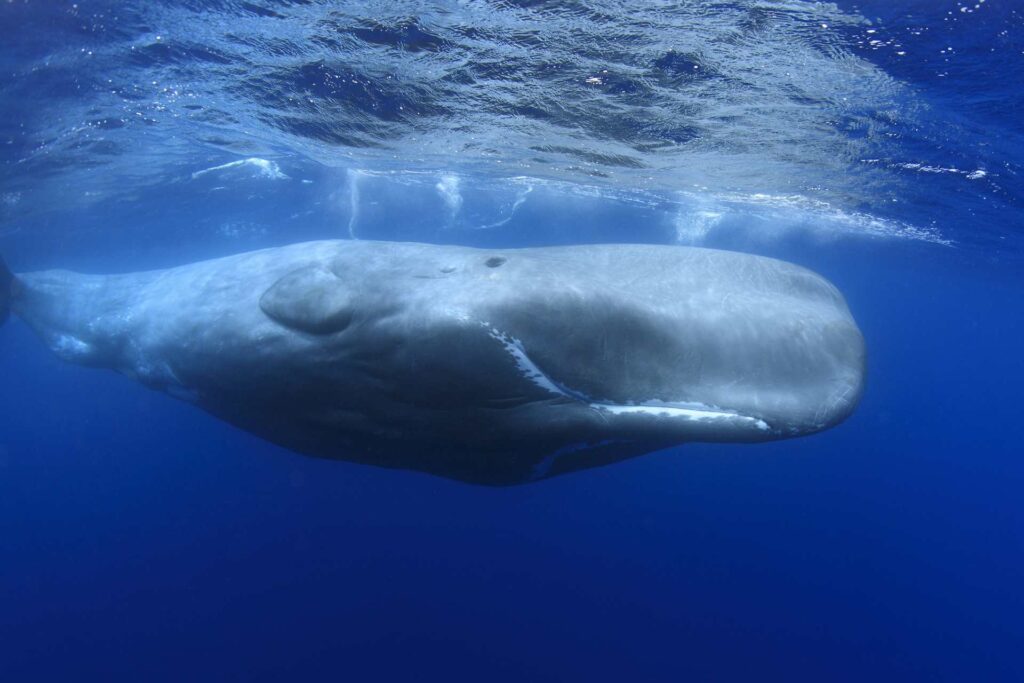

Distribution and Habitat
You can find sperm whales throughout the world’s oceans, from equatorial regions to the edges of the ice in polar seas. They prefer deep water and are commonly found along continental shelves or canyons where the ocean floor rapidly descends.
Diet and Hunting Techniques
Sperm whales have a diet largely consisting of deep-sea creatures, with squid making up the majority of their intake. They’re known to dive several thousand feet to hunt their prey, staying submerged for up to an hour.
Social Structure and Behavior
You might be interested to learn that sperm whales have a complex social structure. The females and young males live in groups called pods, while mature males usually roam the seas alone or in smaller bachelor groups.
Sperm Whale Lifespan and Reproduction
Remarkably long-lived, sperm whales can reach up to 70 years old. Their reproductive patterns are equally interesting, with females giving birth to a single calf after a 12 to 14-month gestation period.
Physical Features of the Sperm Whale
Size and Weight Comparisons
Imagine a creature so massive, it dwarfs most things in the ocean. Sperm whales are like the ocean’s version of double-decker buses. They can stretch up to a colossal 60 feet in length and tip the scales at a whopping 50 tons. That’s equivalent to the combined weight of six full-grown African elephants – or about 40 small cars!
Unique Body Structure
The body of a sperm whale isn’t just big; it’s like a submarine designed by nature. Its physique is stockier and more robust than any other whale, almost like a muscular powerlifter of the sea. This build isn’t just for show – it’s a superpower that allows the sperm whale to plunge into the deep ocean, withstanding pressures that would crush other creatures.
The Spermaceti Organ: Purpose and Theories
Now, let’s talk about the sperm whale’s most mysterious feature: the spermaceti organ. Sitting in its massive head, this oil-filled wonder is like something out of a sci-fi movie. Scientists think this organ plays a key role in the whale’s ability to dive deep and might even be its secret weapon for echolocation – like a natural sonar system!
Diving Capabilities and Respiratory System
But how deep can they go? Sperm whales are the champions of deep diving, reaching over 2,000 meters beneath the ocean’s surface. That’s like diving to the height of five Eiffel Towers stacked on top of each other! They can also hold their breath for an astonishing 90 minutes. Their respiratory system is so efficient it’s like having the best scuba gear built right in, allowing them to refresh 90% of the air in their lungs in a single breath – a record-breaking feat among mammals.
Echolocation and Communication
Mechanics of Echolocation
Think of echolocation as the sperm whale’s built-in, high-tech sonar. These whales send out rapid-fire sequences of high-frequency clicks, which are like the pings of a submarine. These sound waves race through the water at lightning speed. When they hit something – be it a tasty squid or a massive underwater mountain – they bounce back to the whale. By interpreting these echoes, sperm whales can ‘see’ in complete darkness, navigating and hunting in the murky depths where sunlight dares not go.
The Importance of ‘Clicks’ and ‘Cods’
In the sperm whale’s world, ‘clicks’ aren’t just noises; they’re a lifeline. These clicks, used in echolocation, are like the whale’s flashlight in the pitch-black ocean. But there’s more – ‘cods’ are special click patterns, like the Morse code of the sea, used to chat with fellow whales. Through these unique sounds, they share stories, warn of dangers, or even introduce themselves!
Understanding Sperm Whale Vocalizations
Diving into the language of sperm whales is like cracking an ancient code. Their vocalizations are a tapestry of mystery, not entirely deciphered by us yet. These sounds are believed to be bursting with information, from sharing emotions to planning a group hunt. It’s like listening in on an underwater conference call where every grunt, click, and pause means something important.
Interpreting Whale ‘Culture’ through Sound
The fascinating part? Sperm whales might have their own ‘cultures’ and ‘dialects’, identifiable through their unique sound patterns. Like different human accents, these vocalizations vary from group to group. They’re not just random noises but are likely carefully taught and passed down through generations. It shows how these giants of the deep have a complex, rich social life bound and shaped by the symphony of sounds they share.
Feeding Habits and Prey
The Sperm Whale Diet
Sperm whales are the deep-sea diners of the ocean. Their favorite meal? Squid! But they’re not picky eaters – their menu also includes various fish and other mysterious creatures of the deep. Thanks to their ability to dive to incredible depths and stay submerged for lengthy periods, sperm whales can snack on delicacies that other ocean predators can only dream of.
Specialized Hunting Techniques
Hunting in the abyss is no small feat, but sperm whales are masters of it. Picture this: as they dive, their lungs collapse, and their heart rate slows down, conserving precious oxygen for the hunt. In the pitch-black waters thousands of meters below, they use their echolocation superpower to detect and chase their prey like skilled deep-sea detectives.
Giant Squid: The Arch-Nemesis
In the deep ocean, it’s like watching an epic battle from an ancient legend. The giant squid is the sperm whale’s formidable opponent. Imagine the showdown – a massive whale and a giant squid locked in combat, leaving the whale with scars and sucker marks as souvenirs of these intense encounters. It’s a true clash of ocean titans.
Impact on the Marine Ecosystem
Sperm whales are much more than just hunters; they’re guardians of the ocean’s balance. As apex predators, they play a crucial role in maintaining the health of the marine ecosystem. By controlling the population of squids and other prey, they help preserve the delicate equilibrium of life beneath the waves.
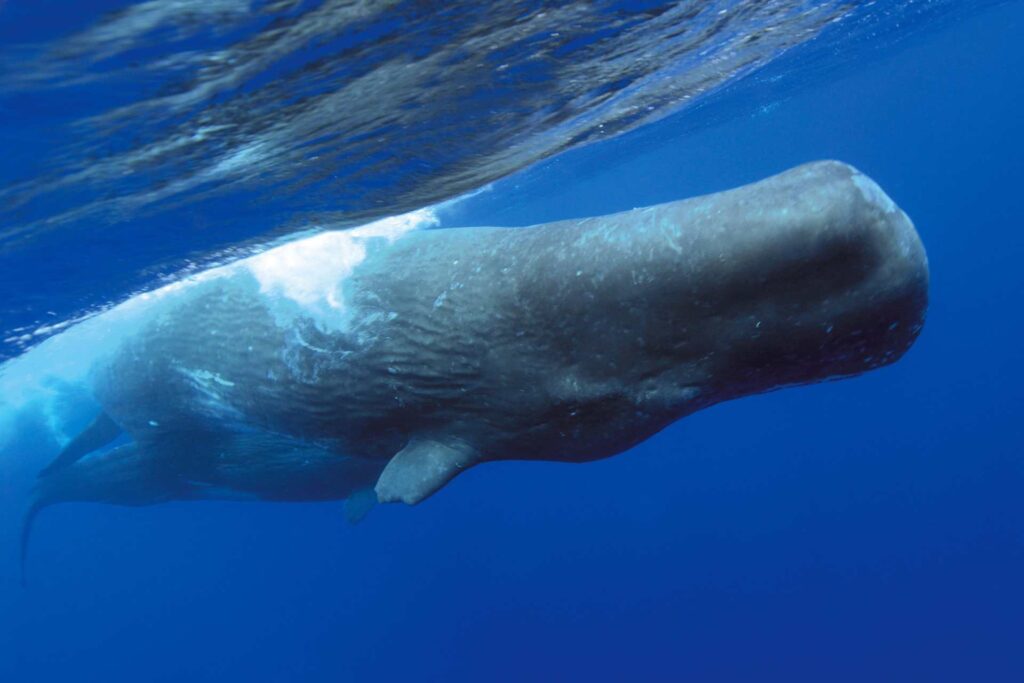

Social Dynamics of Sperm Whales
Matrilineal Groups
In the world of sperm whales, it’s all about family. Female sperm whales and their calves form tight-knit matrilineal groups, like underwater matriarchies. Knowledge is a precious heirloom passed from mother to calf within these groups. These lessons include everything from the best feeding spots to how to communicate in the vast ocean. It’s a rich tapestry of shared behaviors and traditions, weaving together generations of whale families.
Bachelor Pods and Solitary Males
As young male sperm whales grow up, they embark on a rite of passage. Once they hit their teenage years, they wave goodbye to their maternal groups and set off on a new adventure. Some join bachelor pods, bands of fellow adventurers roaming the seas like oceanic brotherhoods. Others prefer the path of the lone wolf, or rather, the lone whale, cruising the oceans in solitary grandeur.
Interactions Within a Pod
Life in a sperm whale pod is like being part of a well-oiled machine. Each member plays a role, especially when it comes to raising the young. It’s communal living at its finest – everyone pitches in to care for the calves. Synchronized diving becomes an art form, a dance of giant shadows beneath the waves. And their communication? It’s a complex, sophisticated language that bonds the pod together, a symphony of clicks and cods that echoes through the ocean depths.
Impact of Social Structure on Survival
In the harsh world of the deep sea, being part of a sperm whale pod is like having an ace up your sleeve. This social structure is more than just for companionship; it’s a survival strategy. Pods offer protection against predators and serve as classrooms where young whales learn the art of survival from their elders. Through group living, these ocean giants ensure that their wisdom, skills, and legacy continue to thrive in the unforgiving depths.
Reproduction and Life Cycle
Mating Rituals and Strategies
In the mysterious depths of the ocean, the love life of sperm whales is a spectacle of nature. Males turn into knights of the deep, competing for the attention of females. It’s a mix of raw power and intricate showmanship – from mighty clashes showcasing strength to subtle displays of aquatic agility and prowess. Each male has his own strategy, vying to be the chosen one in this underwater tournament of courtship.
Gestation and Birth
After winning the mating game, the female embarks on an incredible journey of motherhood. The gestation period is a marathon, not a sprint, lasting a whopping 14 to 16 months. When the time comes, a single calf is born, a mini-giant ready to take on the world. This little one isn’t so little for long – it guzzles down its mother’s rich, fatty milk, growing at an astonishing rate in the safety of the ocean’s cradle.
Calf Development and Weaning
For a sperm whale calf, the pod is both school and sanctuary. Under the watchful eyes of its mother and other pod members, the calf learns the ways of the whale – from diving deep to speaking whale language. This nurturing environment is crucial until the calf is weaned at about two years old, marking its first big step towards independence.
Adulthood and Aging in Sperm Whales
Growing up for sperm whales is a slow and steady journey. They take their sweet time reaching adulthood, with this period stretching over many years. As they age, their lifestyles adapt too. The once mighty deep divers might not plunge into the abyss as they used to, changing not just their dining habits but possibly their social lives as well. It’s a natural shift, part of the rhythm of life in the vast ocean.
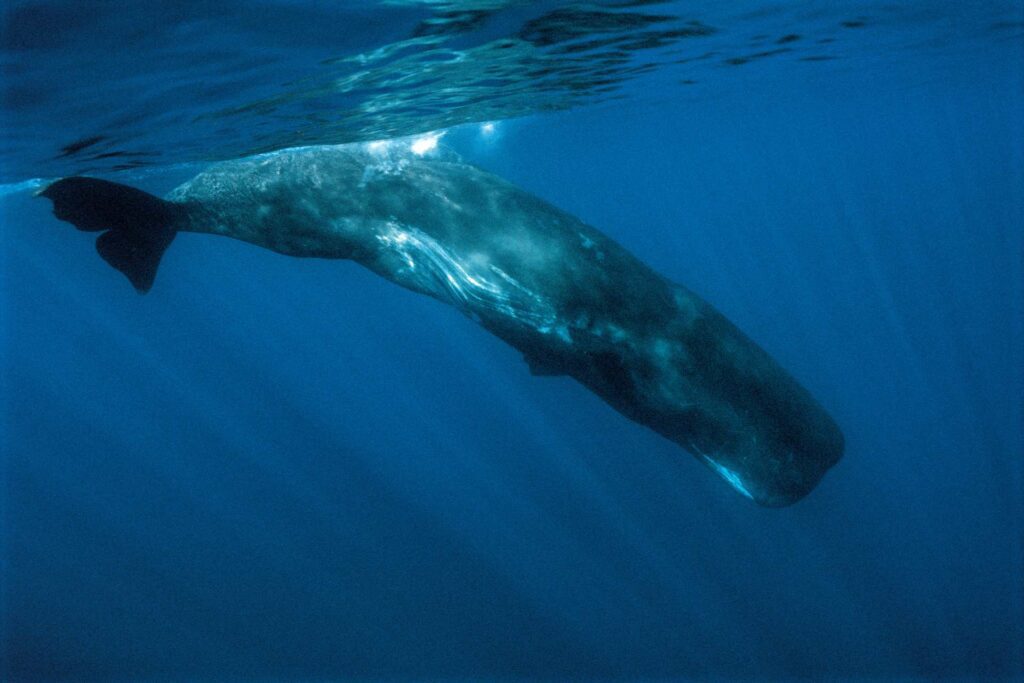

Threats to Sperm Whales
Human-Induced Dangers
Sperm whales face an ocean of challenges, many of which are created by us humans. They sometimes find themselves tangled in a maze of fishing nets, a dangerous trap from which escape is often impossible. Pollution, an insidious invader of their watery home, adds another layer of peril. Then there are the giant ships, thundering through the waves, unaware of the gentle giants they might collide with. These human-induced dangers are a growing threat to the survival of these majestic creatures.
Natural Predators and Survival
While humans pose significant risks, nature itself has its own set of challenges. Young and weaker sperm whales often find themselves on the radar of the ocean’s fearsome predators – large sharks and orcas. These natural hunters of the sea can turn the life of a young sperm whale into a dangerous game of survival, a testament to the harsh realities of the marine world.
Changes in Ocean Ecosystems
The stability of the sperm whale’s world is also rocked by changes beyond their control. Climate change, like a slowly turning tide, is altering ocean temperatures and currents. This environmental shift can play havoc with the distribution of their prey, forcing these giants to alter their behavior and migration patterns. It’s a ripple effect that threatens to unsettle the very rhythm of their existence.
Conservation Status and Efforts
In the face of these challenges, sperm whales are now listed as vulnerable. The race is on to turn the tide. Conservation efforts are focused on minimizing human threats, enforcing international protections, and preserving the health of their ocean habitat. It’s a global effort to ensure that these magnificent creatures continue to thrive in the depths of our oceans.
Sperm Whales and Human Interaction
Historical Whaling and its Impact
The story of sperm whales and humans is tinged with darkness and exploitation. In the past, these majestic creatures were hunted ruthlessly for their valuable oil and spermaceti, a pursuit that led them to the brink of disaster. Whole populations were decimated, leaving a gaping wound in the fabric of the ocean ecosystem. It’s a grim chapter in our shared history, a stark reminder of humanity’s impact on these gentle giants.
Current Oceanic Research and Studies
Today, the narrative is changing. Scientists and researchers are diving deep, both literally and figuratively, into the world of sperm whales. Armed with cutting-edge technology and insatiable curiosity, they are unraveling the mysteries of these deep-sea dwellers. From understanding their complex communication to studying their unique behaviors, current research efforts are crucial in safeguarding the future of these ocean icons.
Whale Watching and Ecotourism
Whale watching has emerged as a beacon of hope, transforming our interaction with sperm whales. This eco-friendly activity allows us to witness the majesty of these creatures in their natural habitat, fostering a sense of awe and respect. It’s not just a tourist attraction; it’s an educational experience that champions conservation and highlights the importance of coexisting harmoniously with our marine neighbors.
Myths and Cultural Significance
Beyond science, sperm whales swim in the seas of our imagination. They have been immortalized in myths, literature, and art, capturing human fascination across different cultures. From being depicted as formidable monsters to wise, gentle giants, they hold a special place in our cultural tapestry, symbolizing our deep and often mystical connection with the natural world.
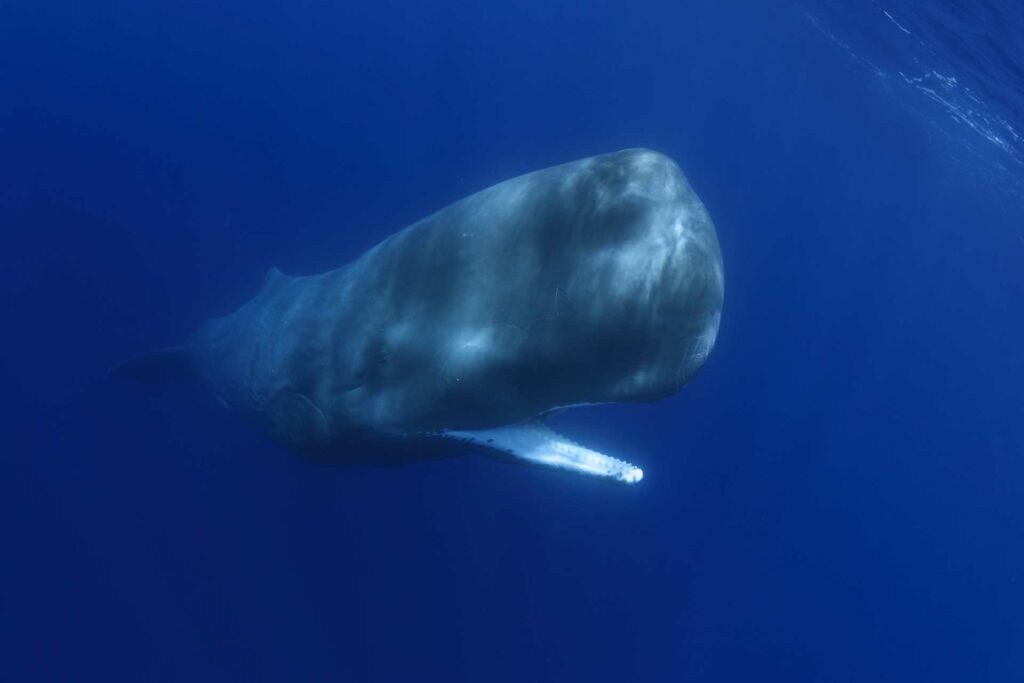

Conservation and Future Prospects
International Laws and Protection
In the international arena, a battle is being waged to protect the mighty sperm whales. Landmark laws and agreements, spearheaded by the International Whaling Commission’s ban on commercial whaling, stand as fortresses safeguarding these creatures. These regulations are not just words on paper; they are global commitments, shields against the threats that once pushed sperm whales to the edge of extinction.
Research and Monitoring Populations
The key to the future of sperm whales lies in our understanding of their present. Scientists are the detectives in this endeavor, conducting extensive research and keeping a vigilant eye on sperm whale populations. This ongoing surveillance is like a health check for the species, providing vital data that guides conservation strategies and helps ensure these oceanic giants don’t just survive but thrive.
Public Awareness and Education
Awareness is a powerful tool in the conservation arsenal. Educating the public about sperm whales transforms ordinary people into informed advocates. It’s about igniting a passion for these magnificent beings and spreading the word about the challenges they face. Each informed individual becomes a voice for change, helping to steer the course towards a more whale-friendly world.
Challenges in Sperm Whale Conservation
Despite these efforts, the path to conservation is fraught with obstacles. Illegal whaling still lurks in the shadows, a ghost of a less enlightened age. Habitat destruction and the looming specter of climate change add layers of complexity to the struggle. These challenges are daunting, but not insurmountable, reminding us that the fight to protect sperm whales is ongoing and ever-evolving.
Advanced Research and New Discoveries
Tracking and Satellite Telemetry
Modern tracking and satellite telemetry provide detailed insights into sperm whale migration patterns, social behavior, and interaction with their environment.
Genetic Studies and Population Genetics
Genetic studies help scientists understand the diversity and health of sperm whale populations, which is essential for effective conservation management.
Advances in Acoustic Research
Recent advances in acoustic research have shed light on how sperm whales use sound to communicate and the importance of these vocalizations in their social structure.
Deep-Sea Exploration and Sperm Whale Habitats
As deep-sea exploration technology improves, researchers are better able to study sperm whales in their elusive deep-water habitats, unlocking the secrets of their complex lives.
FAQ
Why is a sperm whale called a sperm whale?
The sperm whale is named for the spermaceti organ in its head, initially mistaken for sperm by early whalers. This organ contains a large quantity of a waxy substance called spermaceti.
Are sperm whales friendly?
Sperm whales are generally not aggressive towards humans. They are curious and have been known to approach boats, but like any wild animal, they should be observed with respect and caution.
Do sperm whales carry sperm?
Despite their name, sperm whales do not carry sperm. The name comes from the spermaceti organ in their head, mistakenly thought to contain sperm.
Why do sperm whales dive so deep?
Sperm whales dive deep to hunt for their preferred prey, mainly squid, which live in deep ocean waters. These dives also allow them to explore different ocean layers for various food sources.
What is the lifespan of a sperm whale?
The lifespan of a sperm whale is typically around 60 to 70 years, though some may live longer.
Do sperm whales eat sharks?
While the primary diet of sperm whales is squid, they are known to occasionally eat fish and even sharks, especially smaller species.
What is the sperm whale’s favorite food?
The favorite food of sperm whales is squid, including giant and colossal squids. They are well-adapted to hunting these creatures in deep ocean waters.

